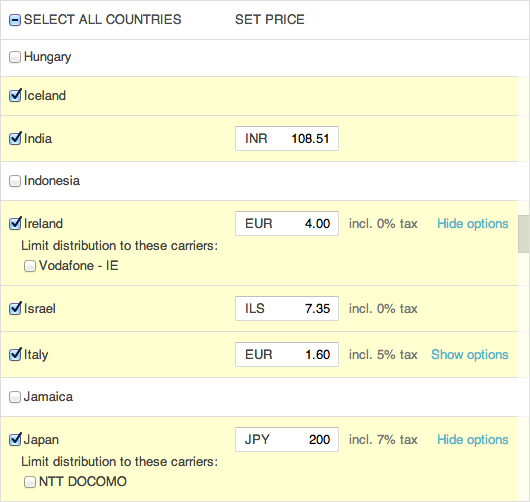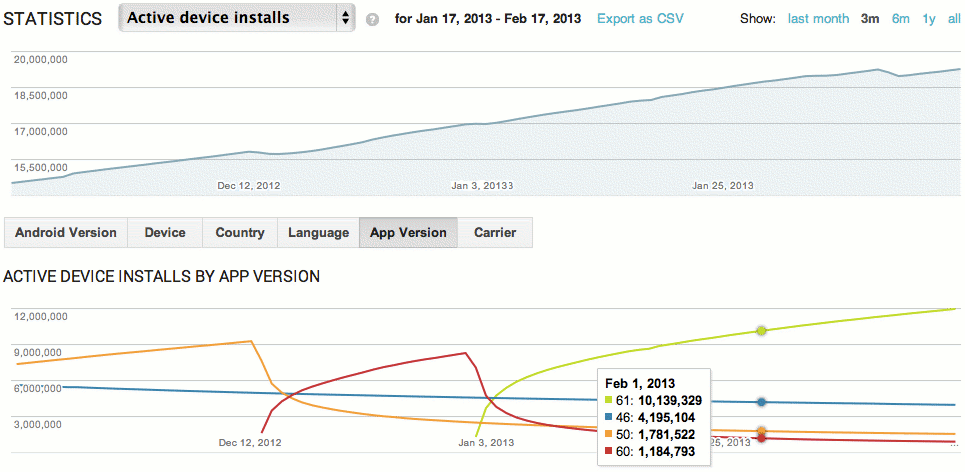Deliver your apps to the users you want, on the devices you want, on your schedule.
Instant publishing, instant updates
On Google Play, you can publish your products to customers instantly. Just upload and configure your product in the Google Play Developer Console and press the Publish button—your app appears in the store listings within hours, not weeks.
Once your app is published, you can update it as often as you want. You can change prices, configuration, and distribution options at any time through the Google Play Developer Console, without needing to update your app binary.
Later, as you add features or address code issues, you can publish an updated binary at any time. Google Play makes the new version available almost immediately and notifies existing customers that an update is ready for download. To streamline the rollout across your customer base, Google Play also lets users accept automatic updates of your app, so that your updates are delivered and installed as soon as you publish them.
Reaching the customers you want

Google Play does more than connect your app with users—it helps you reach the broadest possible distribution across the Android ecosystem, while making sure that your app is only available to the audience that you want to reach.
Geographic targeting
You can use controls in the Google Play Developer Console to easily manage the geographic distribution of your apps, without any changes in your application binary. You can specify which countries and territories you want to distribute to, and even which carriers (for some countries).
When users visit the store, Google Play makes sure that they are in one of your targeted countries before downloading your app. You can change your country and carrier targeting at any time just by saving changes in the Google Play Developer Console.

To help you market to users around the world, you can localize your store listing, including app details and description, promotional graphics, screenshots, and more.
Capabilities targeting
Google Play also lets you control distribution according to device features or capabilities that your app depends on. There are several types of dependencies that the app can define in its manifest, such as hardware features, OpenGL texture compression formats, libraries, Android platform versions, and others.
When you upload your app, Google Play reads the dependencies and sets up any necessary distribution rules. For technical information about declaring dependencies, read Filters on Google Play.
For pinpoint control over distribution, Google Play lets you see all of the devices your app is available to based on its dependencies (if any). From the Google Play Developer Console, you can list the supported devices and even exclude specific devices if needed.
Statistics for analyzing installs and ratings
Once you’ve published your app, Google Play makes it easy to see how it’s doing. The Google Play Developer Console gives you access to a variety of anonymized statistics and custom charts that show you the app's installation performance and ratings.
You can view data and charts for active, daily, and total installs per unique devices or users, as well as upgrades and uninstalls. You can also view the app's daily average user rating and its cumulative user rating. To help you analyze the data, you can view install and ratings statistics across a variety of different dimensions such as Android version, device, country, app version, and carrier.

You can see your app statistics on timeline charts, for all metrics and dimensions. At a glance, the charts highlight your app’s installation and ratings peaks and longer-term trends, which you can correlate to promotions, app improvements, or other factors. You can even focus in on data inside a dimension by highlighting specific data points (such as individual platform versions or languages) on the timeline.
So that you can “take your data with you”, you can download all of your installation data as a CSV file for viewing in the business program of your choice.
Advanced delivery options
Google Play offers convenient options for managing how your apps are delivered to users.
Alpha and beta testing, staged rollouts
It's always valuable to get real-world feedback from users, especially before launch. Google Play makes it easy to distribute pre-release versions of your app to alpha and beta test groups anywhere in the world. You can start with a small group of alpha testers, then move to a larger group of beta testers. Once users are added, they access your app's store listing and install the app. User feedback from alpha and beta testers goes directly to you and is not posted as public reviews.
To help you ensure quality and protect your app ratings, you can choose a staged rollout when launching an app or an update. With staged rollout, you distribute the production version of your app to a percentage of users. You can adjust the percentage as you go, starting small and increasing until your app is available to all users.
Multiple APK support
In most cases, it’s easy to create an app that supports all of your targeted screen sizes and platform versions from a single APK. Distributing a single APK to all of your users is a highly recommended approach, because it’s the easiest way to manage and maintain the app. If you need to deliver a different APK to devices, Google Play provides a way to do that.
An option called Multiple APK support lets you create multiple APK packages that use the same package name but differ in their OpenGL texture compression formats, screen-size support, or Android platform versions supported. You can upload all of the APKs to Google Play under a single product listing and Google Play selects the best APK to deliver to users, based on the characteristics of their devices.
The APK Expansion Files option lets you upload up to two secondary downloads for each published APK, including multiple APKs. Each of the two expansion files can be up to 2GB each and can contain any type of code or assets. When you upload the expansion files, Google Play hosts them for free and handles the download of the files as part of the normal APK installation.
Protecting your app
Google Play provides two key features to help you protect your application against piracy — Google Play Licensing and app encryption.
Google Play Licensing is a network-based service that you implement in your app. The service lets your app query a trusted licensing server at runtime, to determine whether the app is licensed to the current device user. You can use the licensing service to protect any app, even apps that you distribute for free. For an overview of the service, see Application Licensing.
Additionally, Google Play offers app encryption to help protect your priced apps. When delivering your priced apps to devices running Android 4.1 or higher, Google encrypts the app binary so that it can be run only by the user who downloaded it, on the device to which it was originally downloaded. Your priced apps benefit from app encryption automatically — there's no extra development work or configuration needed.